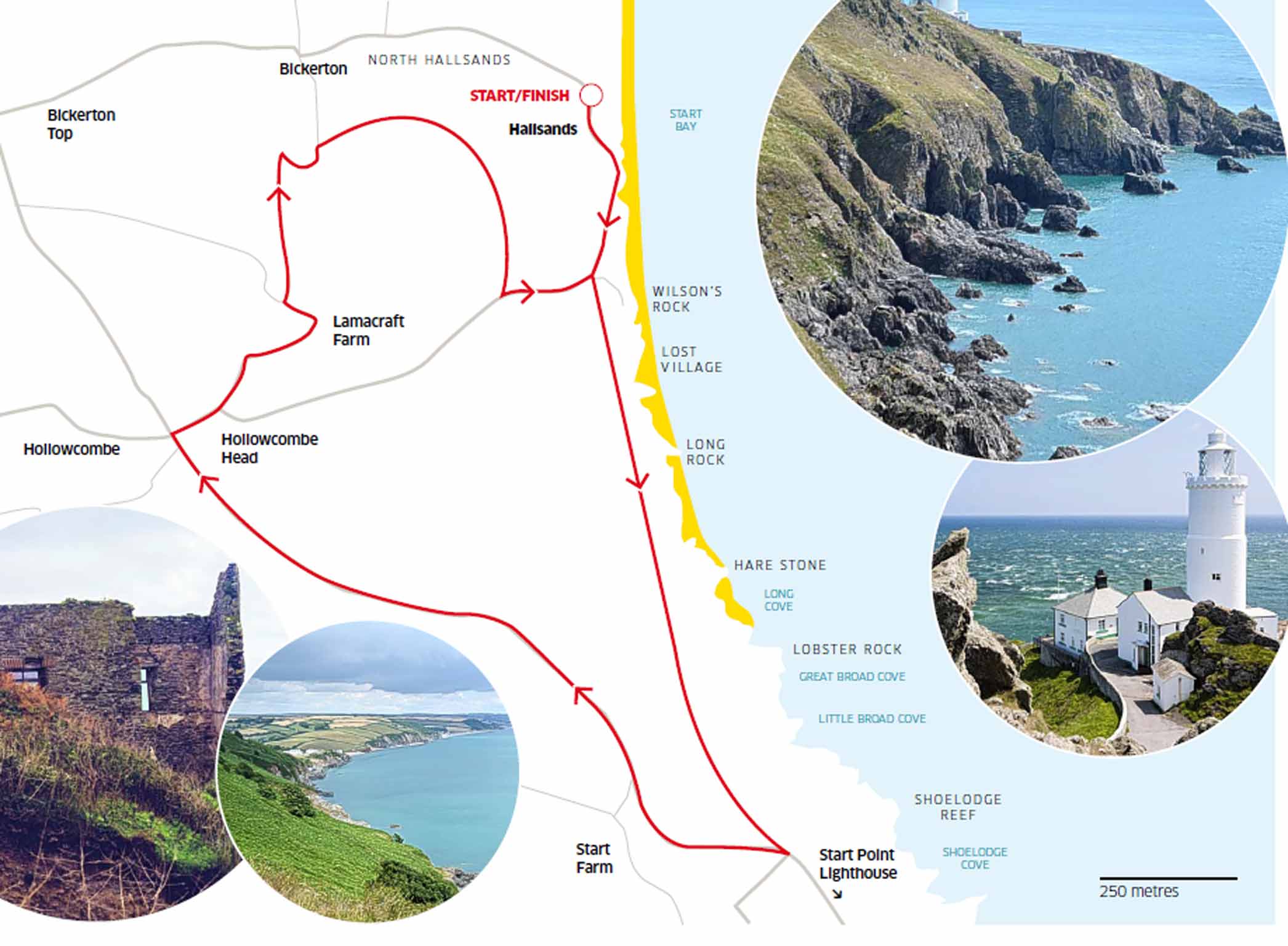The late, great travel writer Eric Newby described the smell of the English sea as so strong it was "like a biff on the nose". This describes perfectly how it hits me as I walk towards Start Point lighthouse in south Devon. There's an easterly wind funnelling across Start Bay, a force six, gusting force eight. The waves pummel the coast, churning up brown sand; a little further out the water is a metallic blue, raked with sea spray.
I've set off from the outpost of North Hallsands. This is a beautiful spot, tucked away in the bottom right-hand corner of the South Hams, and reachable only by a series of too-narrow lanes or by the coast path.
Wild elements are something of a running theme in this place. A short walk south from the tiny community are the remains of the original village of Hallsands, a few broken and fragmented brick walls, mantled with ivy, turf and lichens. A narrow road runs out, dizzyingly, into thin air from the rock ledge, a wave-cut platform dating back 120,000 years.
History has not been kind to Hallsands. In January 1917, it was washed away by a ferocious storm off the south Devon coast. By itself, the storm would not have been enough to sweep away the village, but that process had begun 21 years earlier when, in order to feed the demand for concrete at the expanding naval dockyard near Plymouth, shingle was dredged along this coastline. Despite protests, inquiries, and occasional attempts to rebuild the lost shoreline, the level of the beach by Hallsands fell by more than four metres. The storm waters of 1917 finally overwhelmed the village. Though no lives were lost, all but one house were dismantled by the elements.
The small community of Hallsands – a dozen or so houses about 600 yards from the site of the original village – got a sharp reminder of the power of the sea in the winter of 2013-2014, when gales pummelled the beach into submission, breaching sea walls, and leaving urgent remedial work in its wake. Today, asteroid-shaped boulders have been stacked up to keep the tide at bay. The topography of the sea bed also has its say. Running north-east across Start Bay are the Skerries, a rocky reef that can be as shallow as two metres below the surface at low tide. This acts as a barrier to sediments and forces waves into the southern part of the bay. The coast path, 100m above the sea, is a glorious place to take in this spectacle.
Occasional coppices of birch or thick hawthorn hedges provide a semblance of shelter. Ahead is Start Point, a jagged headland that cuts for a mile into the sea. The name comes from the Anglo-Saxon word "steort", or tail. I look back for a truly dreamy view of the coastline. Hallsands is now shrunken to a tiny, huddled community. Beyond lies a sliver of Slapton Ley, the freshwater lake separated by a thin causeway from the sea. The slender finger of yellow is Blackpool Sands. Further round, the coast arcs east to Dartmouth and Kingswear, slumping into the sea at Froward Point.
For respite, I turn inland, past the lonely, wobbling wooden ticket kiosk at Start Point Lighthouse car park. It's a quiet lane that opens up a landscape of classically swooping, rising, Devon hills that act as gatekeepers to the harsher, bonier contours of Dartmoor behind.
I pass under the eerie gaze of two giant transmitter masts and reach Hollowcombe Head, one of those isolated lane junctions that are a real feature of Devon. A spectral wooden signpost marked with a medieval-looking cross is staked at its heart.
The lane descends and becomes an enclosed footpath, swathed in ferns and mosses, overhung with leaf-free sycamore branches dense enough to keep out the light, even in winter. Age-old stone walls look to be on the point of collapse and are straddled by the roots of beech trees.
I walk through the smallest of small hamlets and head gently upwards again along a Devon lane, a path with high-sided hedges. The lane opens up and, a little unexpectedly, I'm walking towards Start Point once again. I check the map. I'm on the right track but am left wondering what the no-nonsense, direct-route Romans might have made of such roundabout, meandering ancient lanes. Maybe early Britons liked to dither as much as modern- day ramblers.
Returning to the car park, I briefly revisit the devastated village. The information panels here are excellent and paint a shocking picture of industry and officialdom. They include a poem by John Masefield: "But that its wretched ruins then/ though sunken utterly/ will show the brute greed of men/ helps feed the greedy sea."
Staying there
Mark Rowe was a guest of Coast & Country Cottages (coastandcountry.co.uk 01548 843773), which offers more than 430 properties across Salcombe, Dartmouth, and the surrounding south Devon countryside. A three night short break at Fulmar, North Hallsands, starts from £542.
More information
Salcombe Tourist Information Centre (01548 843927; salcombeinformation.co.uk).
Subscribe to Independent Premium to bookmark this article
Want to bookmark your favourite articles and stories to read or reference later? Start your Independent Premium subscription today.


Join our commenting forum
Join thought-provoking conversations, follow other Independent readers and see their replies